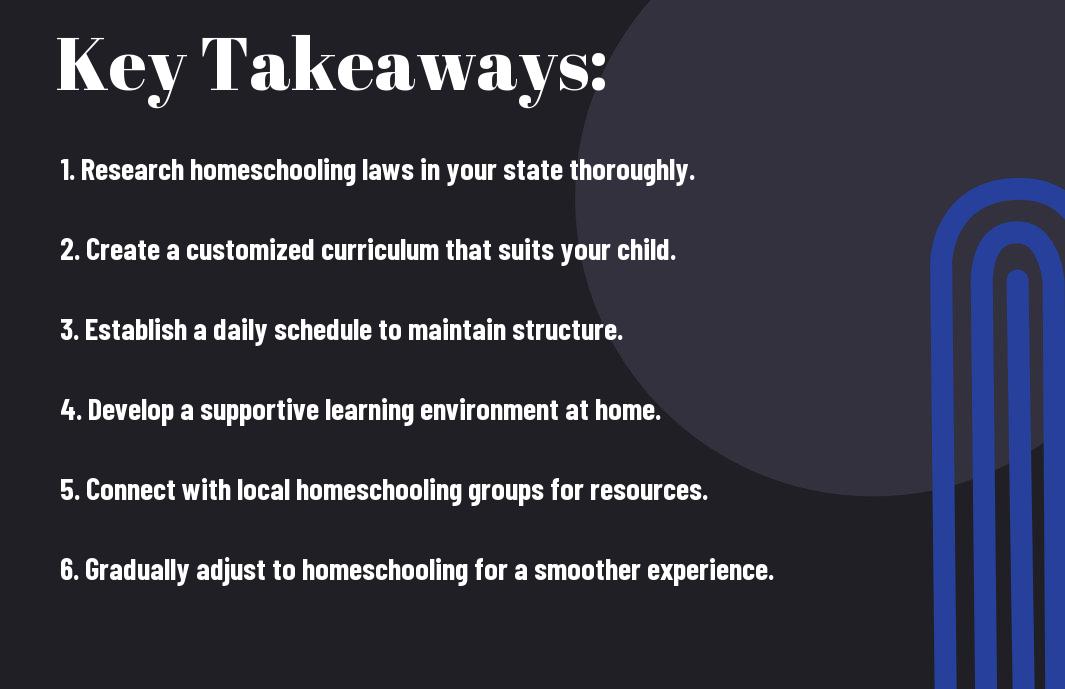There’s a significant shift that comes with transitioning from public school to homeschool, and it’s necessary to approach it with a strategic mindset. You’ll need to consider key factors such as curriculum selection, establishing a daily routine, and ensuring compliance with state regulations. This guide will provide you with the vital steps to ensure your transition is smooth and your child thrives in their new learning environment.
Key Takeaways:
- Evaluate your child’s learning style and preferences to tailor a homeschooling approach that suits their needs.
- Research local homeschooling laws and regulations to ensure compliance and a smooth transition.
- Create a structured yet flexible schedule that incorporates both educational and recreational activities to support your child’s overall development.


Understanding Homeschooling
While transitioning from public school to homeschooling can be daunting, it is vital to grasp the full scope of what homeschooling entails. This educational approach allows you to tailor your child’s learning experience to suit their individual needs, preferences, and lifestyle. Unlike traditional public schooling, homeschooling provides the flexibility to explore various subjects in-depth and at a pace that works for your family. By fostering a nurturing environment, you can promote a love for learning and facilitate your child’s academic and personal growth.
Benefits of Homeschooling
Homeschooling offers a plethora of advantages that you may find beneficial for your child’s educational journey. You can create a customized curriculum that resonates with your child’s interests, strengths, and learning styles. This personalized approach often leads to better retention and understanding of material, as children engage with topics they are passionate about. Additionally, homeschooling allows for greater flexibility in scheduling, enabling you to incorporate real-world experiences, such as field trips and community involvement, that can enhance traditional academic instruction.
Common Misconceptions
By considering homeschooling, you may encounter various misconceptions that could influence your decision. One prevalent myth is that children who are homeschooled lack socialization opportunities. In reality, many homeschooling families actively seek out social activities, such as co-ops, sports teams, and community events, providing their children with ample opportunities to interact with peers. Another misconception is that parents must have advanced degrees to effectively teach their children. In truth, many resources are available to guide you through the homeschooling process, making it possible for anyone to educate their child successfully.
Due to the rise of homeschooling, you might find that many myths linger in public perception. For instance, some people believe that homeschooled students struggle academically compared to their traditionally schooled peers. However, research suggests that homeschooled children often outperform their public school counterparts on standardized tests and enjoy a more enriched learning experience. Additionally, the notion that homeschooling isolates families is misleading; many engage with vibrant homeschooling communities, fostering connections and friendships that extend beyond the classroom. Understanding these misconceptions will help you make informed decisions about your child’s education and embrace the benefits that homeschooling can offer.

Assessing Your Child’s Needs
Some parents find that assessing their child’s specific needs is vital when transitioning from public school to homeschool. This assessment can guide you in creating a tailored educational plan that addresses your child’s strengths, weaknesses, and preferences. To ease this transition, consider exploring Tips to Transition to Homeschooling from Traditional School. This resource can provide valuable insights and practical suggestions for ensuring your child flourishes in a homeschool setting.
Learning Styles and Preferences
Your child’s learning style plays a significant role in shaping their educational experience. Some children thrive in hands-on activities, while others excel through reading or visual aids. By identifying whether your child is a visual, auditory, or kinesthetic learner, you can tailor your homeschooling approach accordingly. This understanding fosters a more engaging, effective environment that meets their individual needs, potentially increasing their motivation and enjoyment in learning.
Academic Evaluation
After you have a clearer understanding of your child’s learning styles, it’s necessary to evaluate their academic standing. This evaluation will help you determine where their skills lie and which subjects may require more focus. Identifying these areas allows you to provide a targeted curriculum that supports their development, ensuring they receive the necessary assistance when overcoming challenges. You might want to look into various assessment tools or standardized tests designed for homeschooled children to gauge their academic level accurately.
Your evaluation should focus on key subjects such as math, reading, and writing, while also taking note of any gaps in knowledge that may need attention. This ensures that your child is not only able to catch up but can also excel in their studies. By conducting a comprehensive academic evaluation, you establish a solid foundation for your homeschooling journey, enabling you to create a personalized curriculum that nurtures your child’s unique abilities and strengths.

Researching Homeschooling Methods
Unlike public schooling, homeschooling offers a variety of methods that cater to different learning styles and family needs. It’s vital for you to take the time to explore these approaches before making your final decision. Understanding the various methods available will empower you to tailor your homeschooling experience to suit your child’s educational needs and personal interests, ensuring a more engaging and effective learning environment.
Traditional vs. Unschooling
An important distinction in homeschooling methods is between traditional structured education and unschooling. The traditional approach often resembles a classroom setting, where you might follow a predetermined curriculum, establish set schedules, and use textbooks to guide your teaching. This method can provide a familiar structure that some parents and children appreciate, especially if you’re transitioning from a public school environment. On the other hand, unschooling is a more fluid approach that focuses on allowing your child to lead their learning based on their interests and curiosities. This method encourages independent exploration and discovery, fostering a love of learning but requiring you to be adaptable and flexible.
Online vs. Offline Resources
Any successful homeschooling experience often hinges on the resources you choose to utilize. Online resources are abundant and can include interactive lessons, video tutorials, and access to a vast array of educational platforms. These tools can be advantageous as they provide a rich multimedia experience and often allow for personalized learning paths. In contrast, offline resources such as textbooks, workbooks, and hands-on materials offer tangible learning experiences and are usually less dependent on technology, which can be beneficial if you want to limit screen time.
Considering the wealth of options at your disposal can help you create a balanced learning experience for your child. Using a combination of online and offline resources allows you to cater to diverse learning styles and preferences. For instance, utilizing interactive websites for subjects like math and science can engage your child, while including hands-on projects and field trips can reinforce concepts without the screen. As you explore various materials, think about your child’s unique interests and learning preferences to determine the right mix for your homeschooling experience.
Legal Requirements for Homeschooling
All states have different legal requirements for homeschooling, and understanding these regulations is crucial for a smooth transition from public school. You will need to familiarize yourself with your state’s homeschooling laws to ensure that you comply with all regulations. This typically involves registering your homeschool with your local school district and maintaining necessary documentation to demonstrate that you are meeting educational standards. By staying organized and proactive, you can navigate the legal landscape with ease and focus on providing the best education for your child.
Registration and Documentation
Any homeschooler must be aware of the importance of registration and documentation in your state. Most states require you to formally register your homeschool, which may include submitting an intent to homeschool form or a notice of withdrawal from the public school your child previously attended. Additionally, you may need to maintain educational records, including attendance logs, assessment results, and curriculum outlines. These records not only keep you compliant with state laws but also help track your child’s learning progress.
State-Specific Laws
For effective homeschooling, it’s vital that you understand the specific laws governing your state. Every state has different requirements regarding notifications, curriculum choice, assessment, and instructional hours. Some states have stricter regulations, requiring standardized testing or curriculum approval, while others are more lenient, allowing for more parental discretion in educational methods. It’s wise to visit the official website of your state’s department of education or a trusted homeschooling organization to gather this information.
It is crucial to familiarize yourself with state-specific laws to avoid potential legal complications. Some states may impose penalties for failing to comply with their regulations, including fines or retroactive enrollment in public schools. Knowledge of these laws can help you make informed decisions about educational methods, curricular choices, and assessment requirements, enabling you to create a positive homeschooling environment tailored to your child’s needs while adhering to legal mandates.
Creating a Homeschooling Plan
Your success in transitioning from public school to homeschooling hinges on the thoughtful creation of a tailored homeschooling plan. This process involves defining your educational goals, establishing a curriculum, and structuring daily routines that best support your family’s learning environment. A well-rounded plan will not only guide your teaching strategies but also foster a rich and engaging educational experience for your children.
Curriculum Selection
After you have set your educational goals, the next step involves selecting a curriculum that aligns with those objectives. There are various options available, ranging from traditional textbook-based programs to more progressive and hands-on approaches, such as project-based learning and unschooling. It’s critical to assess your child’s learning style and interests, as well as your teaching preferences, when evaluating different curricula. You can also consider incorporating a blend of resources—online courses, local co-ops, or community resources—to create a more dynamic learning experience tailored to your family.
Daily Schedule and Routine
Selection of a daily schedule and routine is necessary to foster an effective homeschooling environment. You’ll want to create a consistent framework that balances academic subjects, enrichment activities, and breaks. Determine how many hours you want to dedicate to schoolwork each day and set aside time for subjects such as math, reading, science, and social studies. Be sure to include ample opportunities for hands-on learning, physical activity, and family bonding. Given the flexible nature of homeschooling, you can adapt your schedule to fit your family’s needs, fostering a more personalized learning experience.
Also, having a consistent daily routine can greatly enhance your child’s ability to focus and stay engaged. Establishing specific times for lessons, snacks, and breaks can create a sense of stability and predictability, which is beneficial for both you and your students. Be open to adjustments as you discover what works best for your family—whether that’s incorporating field trips, hands-on projects, or collaborative learning with friends. Maintaining a positive approach to your homeschooling schedule will encourage a love for learning in your children and help you establish a productive home education environment.
Building a Support Network
Despite the challenges that may arise during the transition from public school to homeschooling, establishing a robust support network can significantly ease this journey. Connecting with like-minded families not only offers you emotional support but also a wealth of shared knowledge and resources. Engaging with other homeschoolers enables you to exchange ideas, teaching methods, and solutions to common obstacles. It can also foster a sense of community for both you and your children, making this new educational path feel less isolating and more enriching.
Connecting with Other Homeschoolers
Among the most effective ways to build your support network is to seek out other homeschoolers in your local area. Local homeschool co-ops can offer your family both educational opportunities and social interactions, ensuring your children engage with peers outside of a traditional classroom setting. Additionally, participating in online forums and social media groups allows you to connect with a broader community of homeschoolers, where you can ask questions and share experiences. Whether through organized groups or informal meet-ups, these connections provide invaluable support and encouragement.
Resources for Parents
Homeschoolers have access to a plethora of resources designed to facilitate a smooth transition for both parents and children. Numerous organizations and websites offer curricula, lesson plans, and teaching strategies tailored for homeschool environments. Moreover, you can find local and online classes that cater to specific subjects or interests, giving your children the chance to dive deeper into topics they are passionate about. Utilizing these resources not only enhances your homeschooling experience but also equips you with the tools to foster your child’s learning effectively.
And while exploring resources, make sure to take advantage of free online courses, educational podcasts, and webinars geared towards homeschooling parents. These tools can provide you with practical teaching techniques as well as insights into the latest educational trends. Also, local libraries and community centers may offer materials and programs specifically for homeschoolers, allowing you to incorporate diverse learning experiences into your curriculum. Building your support network with these resources can lead to a more fulfilling homeschooling experience, ensuring that both you and your children thrive on this educational adventure.
To wrap up
Conclusively, transitioning from public school to homeschool can be a rewarding experience if you take the right steps to ensure a smooth change. It is imperative to begin by researching local homeschooling laws and regulations to understand your legal obligations. Assessing your child’s needs, preferences, and learning style will help you develop a tailored educational plan that resonates with them. Additionally, setting up a structured yet flexible daily routine can foster a productive learning environment, creating a sense of stability during this life change.
As you navigate this transition, actively seeking out support from the homeschooling community can provide you with invaluable resources and encouragement. Connecting with other homeschooling families, joining local co-ops, and utilizing online platforms for advice and curriculum materials can enhance your journey. By equipping yourself with the right tools and support, you can create a fulfilling and enriching homeschooling experience that meets your family’s unique educational goals.
FAQ
Q: What are the first steps a parent should take when considering homeschooling after public school?
A: When transitioning from public school to homeschooling, the initial steps involve researching state regulations concerning homeschooling, including any required notice or registration. Parents should evaluate their educational philosophy and the resources available to them, such as curriculum options, support groups, and learning materials. Additionally, it’s beneficial to create a schedule that accommodates the family’s lifestyle while fulfilling educational goals.
Q: How can families ensure a successful social transition for their child moving from public school to homeschool?
A: To ensure a smooth social transition for children, families can engage them in local homeschooling groups or extracurricular activities, such as sports, art classes, or community service. This provides opportunities for social interaction with peers outside of a traditional classroom setting. Organizing playdates and cooperatives with other homeschooling families can also facilitate friendships and ease the adjustment period.
Q: What strategies can help maintain a structured learning environment at home?
A: Establishing a structured learning environment at home can be achieved by creating designated study areas and setting consistent daily routines. Parents can incorporate a mix of scheduled subjects and free exploration to keep children engaged. Utilizing tools like planners or digital apps can help to organize lessons, track assignments, and assess progress. Frequent check-ins and feedback can also work to motivate children and keep them focused on their educational goals.

